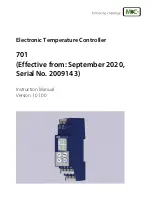
IM00120
60
IM00120
MSC-3 Start Up
2.2. Specifically check the desired maximum motor frequency at which the process may be safely
driven. Refer to
C02 MAX Hz
to check the maximum Hz setting.
2.3. Configure the analogue input that you intend to use for the PV signal (feedback transducer),
so that it is the correct type (Volts, mA) and signal range (0-10V, 4-20mA etc). See
G02 AI(10,
11)
Config on page 95 for the analogue input on the control board or
G10 AI(32,34)
&
G14
AI(52,54)
on page 105 for the two possible additional analogue inputs on extended features
options that may be fitted.
The scaling that is applied for the PV signal (for example 4-20mA represents 0 to 100% of the
transducer’s pressure range) is also used to interpret the set-point value (SV) setting. To control
a pressure to a value that is equivalent to 50% of the pressure transducer range, set the SV to
50%.
For example, you have an air pressure transducer with a range of 0-100 Pa for 4-20 mA. You
want to control the pressure to 50 Pa. Configure the analogue input you will use for the pressure
transducer (the PV signal) to a minimum input of 4 mA, maximum input of 20 mA, leave the
Ref@Min
in and
Ref@Max
in at their default values of 0% and 100% respectively. A set-value
(SV) setting of 50% will then correspond to a pressure of 50 Pa.
2.4. Perform any analogue input adjustments of each analogue input in use.Ensure the chosen
analogue input for the PV signal is selected in the
H07 PV
choice menu.
2.5. Ensure the chosen reference for the SV signal is selected in the
H06 SV
choice menu.
2.6. Perform any analogue output adjustments of each analogue output in use.
2.7. Perform any PID parameter adjustments e.g.
H01 PB (%)
,
H02 Ti (sec/r)
, etc.
2.8. To close the loop the running mode reference (Remote, Local, ESO, JOGFWD or JOGREV) must
be set to >
PID Output.
3. Tuning
CAUTION!
The following steps are applicable in most cases. However, running the controller
system without defined limits must be done with caution in case excessive speeds
result in hazardous conditions or damage.
3.1. PV signal verification: Run the drive/motor/process at known set point and check the feedback
signal is correct for the operating point.
3.2. If possible, operate the system at the maximum (safe) operating point and verify that the PV
signal is now at the expected level.
3.3. Switch off the integrator by setting
H02 Ti (sec/r)
to zero.
3.4. Closing the loop: After the loop has been closed, observe the PV behaviour. If the system is
unstable, increase the
H01 PB (%)
to stabilize the system. In general, increasing the
H01 PB (%)
will stabilize the system. Decreasing
H01 PB (%)
will produce a faster response at the expense
of system stability.
3.5. If the system response oscillates momentarily, the system is under damped. An increase of the
derivative time H03 Td (sec) can improve damping but an excessive value may increase the
systems’ response to noise.
3.6. Allow the system to settle. If the PV value does not equal the SV value, then the system has
a steady state error. To remove steady state error, set the
H02 Ti (sec/r)
to the maximum.
Decrease the
H02 Ti (sec/r)
to remove the steady state error more rapidly.
3.7. Minor adjustments to
H01 PB (%)
,
H02 Ti (sec/r)
and
H03 Td (sec)
may be performed to
achieve the desired system response. Use the PID Tuning Summary below for general remedies
to common problems.
3.8. Change the
H08 PID
Units and
H09 PID Scale
to represent the signal PV and SV signals
correctly on the console display.
Содержание MSC-3
Страница 1: ...MSC 3 Instruction Manual INVENTIVE TECHNOLOGY DSP II...
Страница 3: ......
Страница 6: ...IM00120 iv IM00120...
Страница 14: ......
Страница 59: ...IM00120 45 IM00120 MSC 3 Instruction Manual Extended Features Option Wiring...
Страница 60: ......
Страница 157: ......
















































